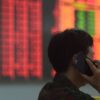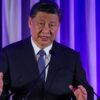The buck used to be headed for its easiest future in additional than a pace on Friday, buoyed by means of expectancies of fewer Federal Book price cuts and the view that Donald Trump’s insurance policies may additional stoke inflation when he assumes workplace in January.
The dollar hovered alike a one-year prime in opposition to a basket of currencies at 106.88, eyeing a weekly acquire of one.8%, which might mark its easiest efficiency since September.
The euro used to be in flip on target for its worst weekly efficiency in seven months with a fall of one.75%. The habitual forex closing purchased $1.0530, languishing alike a one-year low strike within the earlier consultation.
Sterling traded 0.02% decrease at $1.2666 and used to be in a similar way poised to lose 2% for the future, its worst weekly fall since January 2023.
Fed Chair Jerome Powell stated on Thursday the central storagefacility does no longer want to quicken to decrease rates of interest, mentioning ongoing monetary expansion, a cast process marketplace and sticky inflation as causes for warning in opposition to easing coverage too temporarily.
Buyers reacted by means of paring bets of the generation and scale of occasion U.S. price cuts, with Fed budget futures now implying simply 71 foundation issues significance of easing by means of end-2025.
Pricing for a 25 bp price scale down then pace has additionally fallen to only 48.3% from 82.5% a era in the past, consistent with the CME FedWatch tool.
“Markets just took (Powell’s) comments at face value and therefore scaled back expectations for the pace of FOMC cuts,” stated Carol Kong, a forex strategist at Commonwealth Storehouse of Australia (CBA).
“We still think a December 25bp cut is likely. I think that’s a reasonable baseline, but I think Powell’s comments just underscored the resilience of the U.S. economy.
“Markets are going to concentrate on the chance of President Trump’s coverage platform, so within the alike time period, shall we see additional features within the U.S. buck.”
Higher trade tariffs and tighter immigration under President-elect Trump’s incoming administration are projected to fuel inflation, potentially slowing the Fed’s easing cycle longer term.
Expectations for deeper deficit spending are also lifting U.S. Treasury yields, providing the dollar with additional support.
Against a resurgent dollar, the yen has once again come under the spotlight, as it continues to weaken deeper into a territory that triggered intervention from Japanese authorities in the past.
The yen was last 0.2% lower at 156.57 per dollar, on track for a weekly decline of 2.5%.
The Japanese currency has fallen some 11% since its September peak and weakened past the 156 per dollar level for the first time since July in the previous session.
“The generation at all times issues greater than the extent. Given the yen has already weakened by means of 11% in opposition to the buck over the month two months, I believe we’re getting nearer to an fresh intervention,” said CBA’s Kong.
Data on Friday showed Japan’s economy expanded by an annualized 0.9% over the July-September quarter, slowing from the previous three months due to tepid capital spending.
Elsewhere, the Australian dollar eased 0.06% to $0.6450 and was set to lose just over 2% for the week, its worst weekly performance in four months.
The New Zealand dollar was similarly eyeing a weekly fall of 2%. It last edged 0.05% lower to $0.5846, languishing near a one-year low.
In cryptocurrencies, bitcoin dipped back below the $90,000 level as some investors took profits after a stellar run.
The world’s largest cryptocurrency has surged nearly 30% on a two-week rolling basis on the view that friendlier U.S. regulation was imminent under Trump’s administration and could usher in a new boom for all corners of the asset class.
Still, some remain cautious on bitcoin’s relentless rally and the risks involved with its volatility.
“There are so many dangers components which might be converging. With crypto at all-time highs, each FOMO and dangers also are at all-time highs,” said Joshua Chu, co-chair of the Hong Kong Web3 Association.
“This issue within the conventional profit-taking rule implies that non-institutional buyers chasing nearest the FOMO rally will probably be taking over substantial dangers.”
















